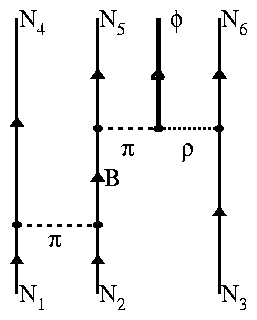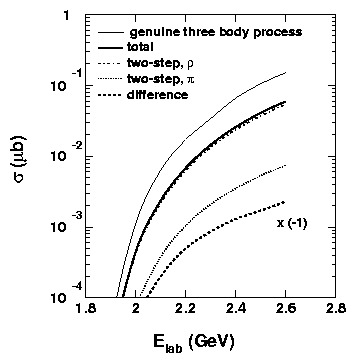|
Currently there is much interest in subthreshold production
of heavy mesons in relativistic nuclear collisions. It is
expected that measurements will reveal the change of the
properties of mesons in dense and hot nuclear matter.
Recent measurements [1] of f mesons in Ni+Ni and Ru+Ru
collisions point
to relatively large production cross-sections
which could not be understood till now within the framework
of transport models [2].
Therefore, we study whether three-body
collisions could remarkably contribute to
the production of f mesons in
heavy-ion collisions. Such processes have the advantage that
three nucleons can share their energy. The cross section
for the reaction N+2N ® f + 3N is calculated using
tree-level diagrams indicated
in Fig. 1.
If the momentum of an intermediate particle (r, p,
B) in a diagram
gets on shell its value becomes singular
and the diagram describes two consecutive two-body processes.
Such two-step processes are usually
considered in the transport models. Therefore, we have defined
the genuine
tree-body process after separating the singular parts
from the diagrams.
The upper line in Fig. 2 shows the cross
section for this genuine process.
However, if absorption processes in the medium
are included this cross section is strongly diminished and can even
take a negative
value. The two-step processes with intermediate
p and r
mesons give together a larger cross section than that calculated with
the three-body diagrams, see Fig. 2.
We conclude that genuine three-body
processes are not important in nuclear matter
as most of the strength can be evaluated via consecutive two-body
reactions. In the case considered here the two-step processes
slightly overestimate the cross section.
However, it is necessary that all intermediate particles
which can reach the energy shell are treated properly
within transport-model calculations
as they essentially contribute to particle production.

|
|

|
|
Fig. 1
Topology of tree-level
diagrams contributing to the three-body f meson
production. Further diagrams are used arising from
time reordering and particle exchanges.
|
|
Fig. 2
Cross section of f meson production by a proton hitting a proton
in a proton environment. The thin line gives the three-body
cross section without
intermediate rescattering whereas the other lines show the results
with rescattering. For further details consult [3].
|
References
[1] R. Kotte (FOPI collaboration), Proc. Int. Workshop XXVIII,
Hirschegg, Austria, 2000, p. 112
[2] W.S. Chung, G.Q. Li and C.M. Ko, Nucl. Phys. A 625 (1997) 347
[3] H.W. Barz and B. Kämpfer, Nucl. Phys. A 683 (2001) 594
IKH
05/31/01
© H.W. Barz
|

